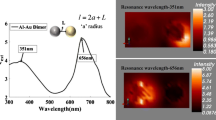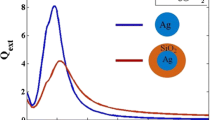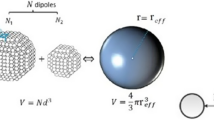Abstract
We demonstrate plasmon coupling phenomenon between equivalent (homodimer) and non-equivalent (heterodimer) spherical shape noble metal nanoparticle (Ag, Au and Al). A systematic comparison of surface plasmon resonance (SPR) and extinction properties of various configurations (monomer, homodimer and heterodimer) has been investigated to observe the effect of compositional asymmetry. Numerical simulation has been done by using discrete dipole approximation method to study the optical properties of plasmonically coupled metal nanoparticles (MNPs). Plasmon coupling between similar nanoparticles allows only higher wavelength bonding plasmon mode while both the plasmon modes lower wavelength antibonding mode as well as higher wavelength bonding mode in the case of heterodimer. Au monomer of radius 50 nm shows resonance peak at 518 nm while plasmon coupling between Au-Au homodimer results in a spectral red shift around 609 nm. Au-Ag plasmonic heterodimer (radius 50 nm) reveals two resonant modes corresponding to higher energy antibonding mode (422 nm) as well as lower energy bonding mode (533 nm). Further, we have shown that interparticle edge-to-edge separation is the most significant parameter affecting the surface plasmon resonances of MNPs. As the inter particle separation decreases, resonance wavelength shows red spectral shift which is maximum for the touching condition. It is shown that plasmon coupling is a reliable strategy to tune the SPR.







Similar content being viewed by others
References
Kreibig U, Völlmer M (1995) Optical properties of metal clusters. Springer, Berlin
Maier SA (2007) Plasmonics: fundamentals and applications. Springer, Berlin
Garcia MA (2011) Surface plasmons in metallic nanoparticles: fundamentals and applications. J Phys D Appl Phys 44:283001
Pillai S, Catchpole KR, Trupke T, Green MA (2007) Surface plasmon enhanced silicon solar cells. J Appl Phys 101:093105
Alok J, Sangita, Sharma RP (2012) A study of nanoellipsoids for thin-film plasmonic solar cell applications. J Phys D Appl Phys 45:275101
Noguez C (2007) Surface plasmons on metal nanoparticles: the influence of shape and physical environment. J Phys Chem C 111:3806–3819
Verma S, Rao BT, Detty AP, Ganesan V, Phase DM, Rai SK, Bose A, Joshi SC, Kukreja LM (2015) Surface plasmon resonances of Ag-Au alloy nanoparticle films grown by sequential pulsed laser deposition at different compositions and temperatures. J Appl Phys 117:133105
Pathak NK, Alok J, Sharma RP (2014) Tunable properties of surface plasmon resonances: the influence of core–shell thickness and dielectric environment. Plasmonics 9:651–657
Naik GV, Shalaev VM, Boltasseva A (2013) Alternative plasmonic materials: beyond gold and silver. Adv Mater 25:3264–3294
Knight MW, King NS, Liu L, Everitt HO, Nordlander P, Halas NJ (2013) Aluminum for plasmonics. ACS Nano 8:834–840
Schuller JA, Barnard ES, Cai W, Jun YC, White JS, Brongersma ML (2010) Plasmonics for extreme light concentration and manipulation. Nat Mater 9:193–204
Wang Y, Plummer EW, Kempa K (2011) Foundations of plasmonics. Adv Phys 60:799–898
Park W (2014) Optical interactions in plasmonic nanostructures. Nano Convergence 1:1–27
Pileni MP (2001) Nanocrystal self-assemblies: fabrication and collective properties. J Phys Chem B 105:3358–3371
Jain PK, El-Sayed MA (2010) Plasmonic coupling in noble metal nanostructures. Chem Phys Lett 487:153–164
Storhoff JJ, Lazarides AA, Mucic RC, Mirkin CA, Letsinger RL, Schatz GC (2000) What controls the optical properties of DNA-linked gold nanoparticle assemblies? J Am Chem Soc 122:4640–4650
Jain PK, Qian W, El-Sayed MA (2006) Ultrafast electron relaxation dynamics in coupled metal nanoparticles in aggregates. J Phys Chem B 110:136–142
Jiang J, Bosnick K, Maillard M, Brus L (2003) Single molecule Raman spectroscopy at the junctions of large Ag nanocrystals. J Phys Chem B 107:9964–9972
Michaels AM, Jiang J, Brus L (2000) Ag nanocrystal junctions as the site for surface-enhanced Raman scattering of single rhodamine 6G molecules. J Phys Chem B 104:11965–11971
Maier SA, Atwater HA (2005) Plasmonics: localization and guiding of electromagnetic energy in metal/dielectric structures. J Appl Phys 98:011101
Ritchie G, Burstein E (1981) Luminescence of dye molecules adsorbed at a Ag surface. Phys Rev B 24:4843
Maillard M, Monchicourt P, Pileni MP (2003) Multiphoton photoemission of self-assembled silver nanocrystals. Chem Phys Lett 380:704–709
Ando M, Kawasaki M, Imazeki S, Sasaki H, Kamata T (2004) Self-aligned self-assembly process for fabricating organic thin-film transistors. Appl Phys Lett 85:1849–1851
Pillai S, Catchpole KR, Trupke T, Zhang G, Zhao J, Green MA (2006) Enhanced emission from Si-based light-emitting diodes using surface plasmons. Appl Phys Lett 88:161102
Liu F, Jin J (2015) Double Fano resonances in plasmon coupling nanorods. J Opt 17:055004
Nordlander P, Oubre C, Prodan E, Li K, Stockman MI (2004) Plasmon hybridization in nanoparticle dimers. Nano Lett 4:899–903
Xu H, Bjerneld EJ, Käll M, Börjesson L (1999) Spectroscopy of single hemoglobin molecules by surface enhanced Raman scattering. Phys Rev Lett 83:4357
Gunnarsson L, Rindzevicius T, Prikulis J, Kasemo B, Käll M, Zou S, Schatz GC (2005) Confined plasmons in nanofabricated single silver particle pairs: experimental observations of strong interparticle interactions. J Phys Chem B 109:1079–1087
Su KH, Wei QH, Zhang X, Mock JJ, Smith DR, Schultz S (2003) Interparticle coupling effects on plasmon resonances of nanogold particles. Nano Lett 3:1087–1090
Romo-Herrera JM, Alvarez-Puebla RA, Liz-Marzán LM (2011) Controlled assembly of plasmonic colloidal nanoparticle clusters. Nanoscale 3:1304–1315
Chen F, Alemu N, Johnston RL (2011) Collective plasmon modes in a compositionally asymmetric nanoparticle dimer. AIP Adv 1:032134
Encina ER, Coronado EA (2010) On the far field optical properties of Ag–Au nanosphere pairs. J Phys Chem C 114:16278–16284
Sheikholeslami S, Jun YW, Jain PK, Alivisatos AP (2010) Coupling of optical resonances in a compositionally asymmetric plasmonic nanoparticle dimer. Nano Lett 10:2655–2660
Bachelier G, Russier-Antoine I, Benichou E, Jonin C, Del Fatti N, Vallée F, Brevet PF (2008) Fano profiles induced by near-field coupling in heterogeneous dimers of gold and silver nanoparticles. Phys Rev Lett 101:197401
Peña-Rodríguez O, Pal U, Campoy-Quiles M, Rodríguez-Fernández L, Garriga M, Alonso MI (2011) Enhanced Fano resonance in asymmetrical Au: Ag heterodimers. J Phys Chem C 115:6410–6414
Kelly KL, Coronado E, Zhao LL, Schatz GC (2003) The optical properties of metal nanoparticles: the influence of size, shape, and dielectric environment. J Phys Chem B 107:668–677
Zhao L, Kelly KL, Schatz GC (2003) The extinction spectra of silver nanoparticle arrays: influence of array structure on plasmon resonance wavelength and width. J Phys Chem B 107:7343–7350
Hao E, Schatz GC (2004) Electromagnetic fields around silver nanoparticles and dimers. J Chem Phys 120:357–366
Vial A, Grimault AS, Macías D, Barchiesi D, de La Chapelle ML (2005) Improved analytical fit of gold dispersion: application to the modeling of extinction spectra with a finite-difference time-domain method. Phys Rev B 71:085416
Luo LB, Xie WJ, Zou YF, Yu YQ, Liang FX, Huang ZJ, Zhou KY (2015) Surface plasmon propelled high-performance CdSe nanoribbons photodetector. Opt Express 23:12979–12988
Draine BT, Flatau PJ (1994) Discrete-dipole approximation for scattering calculations. JOSA A 11:1491–1499
Draine BT, Flatau PJ User guide to the discrete dipole approximation code DDSCAT 7.3, available at http://arxiv.org/abs/1202.3424
Roopak S, Pathak NK, Ji A, Sharma RP (2015) Numerical simulation of broadband scattering by coated and noncoated metal nanostructures using discrete dipole approximation method. Plasmonics. doi:10.1007/s11468-015-0052-x
Pathak H, Alok J, Sharma R, Sharma RP (2015) Optical properties of metal subwavelength structures for realistic geometries in a dielectric matrix using DDA: an error analysis. Plasmonics 10:783–789
Jain PK, Eustis S, El-Sayed MA (2006) Plasmon coupling in nanorod assemblies: optical absorption, discrete dipole approximation simulation, and exciton-coupling model. J Phys Chem B 110:18243–18253
Jackson JD (1999) Classical electrodynamics, 3rd edn. Wiley, New York
Bohren CF, Huffman DR (1998) Absorption and scattering of light by small particles. Wiley, New York
Draine BT, Flatau PJ (2008) Discrete-dipole approximation for periodic targets: theory and tests. JOSA A 25:2693–2703
Draine BT, Flatau PJ (2012) Fast near field calculations in the discrete dipole approximation for regular rectilinear grids. Opt Express 20:1247–1252
Palik ED (ed) (1985) Handbook of optical constants of solids. Academic, San Diego
Author information
Authors and Affiliations
Corresponding author
Rights and permissions
About this article
Cite this article
Roopak, S., kumar Pathak, N., Sharma, R. et al. Numerical Simulation of Extinction Spectra of Plasmonically Coupled Nanospheres Using Discrete Dipole Approximation: Influence of Compositional Asymmetry. Plasmonics 11, 1603–1612 (2016). https://doi.org/10.1007/s11468-016-0216-3
Received:
Accepted:
Published:
Issue Date:
DOI: https://doi.org/10.1007/s11468-016-0216-3




